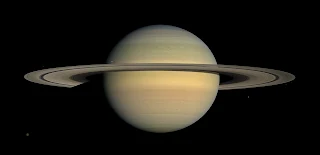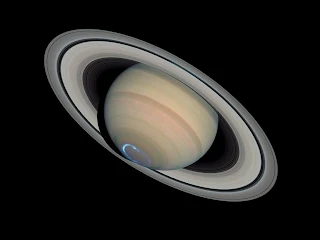SOLAR SYSTEM FAMILY-FACTS ABOUT SATURN, THE JEWEL OF THE SOLAR SYSTEM
Saturn, with its dazzling set of circumferential rings, suspended against the black backdrop of interstellar space is undoubtedly the most beautiful planet in our solar system. Although, it may not be of particular interest to some alien species as there are a multitude of exotic worlds scattered throughout the billions of galaxies across the universe. In fact, every planet is quite unique; Venus has temperatures high enough to melt lead, while on the other hand Earth is filled with a weird thing called 'life'. All in all, one glimpse at the jewel of our solar system can make anyone fall in love with astronomy.
A Bit Of Mythology: The planet and the day of the week, 'Saturday' have both been associated with ''Saturn'', who was the Roman god of generation, wealth, and agriculture. According to the Roman Mythology, He was also known to father Jupiter, Neptune, Pluto, Juno, Ceres and Vesta. His Greek counterpart was the mythological Cronos, a Titan who was later overthrown by his own son, Zeus, the supreme Olympian God. In ancient Hindu mythology, the planet is related to the male deity ''Shani'', and is feared for delivering misfortune and doom.
Basic Facts: Saturn, which is the second largest planet of our solar system, is a gas giant just like Jupiter. By far, it is the lightest planet with a mean density less(about 30%) than that of liquid water. The only thing which gives the sixth planet a distinct position is its unique set of rings, made up principally of ice crystals, and pieces of dirt and dust. Although the rings are not visible without the aid of a telescope, it is officially the last planet which can be viewed as a bright star-like object in our night skies.
 |
| Saturn During Equinox/Image Credits: NASA / JPL / Space Science Institute, Public domain, via Wikimedia Commons |
Planetary Characteristics:
- Orbital & Rotational Characteristics: Saturn is situated at an average distance of 1400 million km or about 9.5 AU from the Sun and has an orbital period nearly equal to 29.5 Earth years. It has an orbital eccentricity of 0.056 and as a result, the perihelion and the aphelion distances are respectively 9.04 and 10.1 AU. Saturn spins about its axis once in every 10 hours and 40 minutes and has a visibly recognizable equatorial bulge. Due to this fast rotation, the mean equatorial diameter is 5904 km longer than the polar diameter. Saturn's axial tilt of 26.73 degrees is similar to that of Earth, and the former also experiences a change of season every seven Earth years.
- A Huge Planet: With a mean radius of 58,232 km compared to Earth's radius of 6371 km, Saturn is the second largest planet in our solar system. Although the ringed planet occupies a volume comparable to 763 Earths, it has the lowest density among all the planets. Saturn has a mass of 95 Earths and together with the largest planet i.e., Jupiter occupies nearly 92% of the total planetary mass in our solar system.
- Internal Structure & Composition: Saturn is composed of 96.3% hydrogen, 3.25% helium, and traces of methane, ammonia, and hydrogen deuteride in the gas phase, followed by icy crystals of ammonia, water and ammonium hydrosulfide. Being a gas giant, there is no true surface for a hypothetical explorer to land on because the interior is mostly hydrogen and helium in their super-critical state, and under the influence of extreme pressure and temperature they are transformed into liquids. It is speculated that deep inside, the planet might have a rocky and metallic core(i.e., iron and nickel) enveloped by layers of liquid metallic hydrogen.
- Atmosphere: Like Jupiter, the atmosphere of Saturn exhibits a banded pattern, but the bands are much fainter and wider near the equator when compared against the intense clouds bands of its predecessor. The composition of the clouds varies with depth, increasing pressure and temperature, and wind speeds can easily reach up to 1,800 km/h. The otherwise featureless atmosphere has an interesting structure i.e., a hexagon shaped jet stream, which is nothing more than a collection of fast flowing air currents situated at the north pole. Quite interestingly, this whole structure rotates with a period of 10 hours and 39 minutes and the pattern's origin is still a matter of heavy debate.
 |
| An Active Storm System/Image Credits: NASA/JPL-Caltech/SSI, Public domain, via Wikimedia Commons |
- Magnetosphere & Magnetic Field: Saturn generates an intrinsic dipolar magnetic field, which has been attributed to the conduction of electrical currents in the interior layers of liquid metallic hydrogen. Although the field strength is quite weaker as compared to Jupiter, Saturn's magnetosphere is strong enough to deflect solar wind plasma and give rise to some spectacular polar aurorae.
 |
| The Most Beautiful Planet/Image Credits: NASA, ESA, J. Clarke (Boston University), and Z. Levay (STScI), Public domain, via Wikimedia Commons |
- Ring System: Saturn's true beauty lies entirely on its set of enigmatic rings. The extensive ring system is made up of particles of ice, rock and dust, which typically range in size from a few micrometers to a few meters. How the rings formed is a matter of debate till this date. Different theoretical models suggest them to be either a product of the disintegration of some large moon under the action of tidal gravity, or some cataclysmic collision between similar large bodies. It could have also formed from the original solar nebula which gave birth to the planets. However, scientists estimate that once upon a time, the rings were quite denser, and at present they are slowly losing material. As a result, within an estimated time period of 300 million years from now, Saturn might lose all of its rings. These rings extend for about 282,000 km from the planet and can be subdivided into the C, B and A, which are the principal and the prominent ones. More recently discovered and fainter rings include the D, E, F and G, and some fainter rings in between them. Quite interestingly, there are sharp gaps within the ring system where particle density falls off rapidly and no one has been able to provide a satisfactory explanation behind the phenomenon except attributing to gravitational effects caused due to the presence of a number of smaller moons within the ring system.
 |
| The Major Rings/Image Credits: NASA/JPL/Space Science Institute, Public domain, via Wikimedia Commons |
- Natural Satellites: Saturn is also surrounded by a plethora of natural satellites, with some ranging in size from a few meters(also known as moonlets) to the largest one, Titan with a mean radius of 2574 km. There are 82 known moons out of which only 53 have been officially recognized, while the remaining 29 are awaiting confirmation. A precise number for the Saturnian moons cannot be given as most of them are irregular satellites having high orbital eccentricity and are minor planets, or debris captured from the collision between other celestial bodies. Apart from these, the ring system is an active region which frequently gives birth to additional new moonlets and it can be assumed that Saturn is probably the only planet in our solar system with the maximum number of moons.
Life & Biological Considerations: Life as we know it may not exist within the cloud layers of Saturn, but some of its icy moons, particularly Titan and Enceladus might possess the necessary conditions. Both of them have a subsurface ocean of liquid water mixed with some salts and hydrocarbons, and a bit of geothermal energy. Assuming that these things are the building blocks of life, then the two worlds are probably the best candidates to look for extraterrestrial life and if we are lucky then they might already harbour some exotic species.
 |
| Saturn and Earth/Image Credits: NASA/JPL/Space Science InstituteEarth image: NASA/Apollo 17 crew, Public domain, via Wikimedia Commons |
Observations & Explorations:
- Observations: Saturn has been observed since ancient times. But modern observations began with Galileo Galilei in 1610. Since his telescope was not powerful enough to resolve the rings of Saturn, he thought that the gas giant might have a set of ears. It was Christiaan Huygens who was able to resolve the ring system under greater telescopic magnification and also discovered Titan, the largest moon of Saturn. Giovanni Cassini discovered four other moons viz., Iaepetus, Rhea, Tethys and Dione, and also the gap presently known as the Cassini Division. William Herschel discovered two additional moons Mimas and Enceladus.
- Explorations: Saturn has been observed with the aid of ground based telescopes and it was not until the famous Cassini-Huygens missions that the scientists gained detailed insight of this wonderful world. The list of missions are as follows:
- Flyby Missions: The first flyby was completed by the Pioneer 11 space-probe in 1979 when it passed within 20,000 km of the planet's cloud tops. Although the low resolution images obtained were not useful enough to discern surface features of the planet and some of its moons, the spacecraft however discovered the F ring, and also found that the gaps were not completely empty of material. More high resolution images of the planet, its rings and some of its moons were obtained when the Voyager 1 and the Voyager 2 spacecraft visited the Saturnian system in the years 1980 and 1981 respectively. The Voyager data revealed surface features of many moons, and made some important observations on Titan.
- Cassini-Huygens Mission: The Cassini space-probe with the Huygens lander, launched on October 15, 1997, which was a joint collaboration by NASA, the ESA and the Italian Space Agency(ASI) provided scientists with the greatest insight into these distant worlds. The Cassini probe became the first spacecraft to orbit Saturn, while the Huygens lander became the first man-made object to land on a moon other than Earth's, as it descended through Titan's thick atmosphere and attained a soft touchdown. Images sent by the Huygens lander revealed an icy surface adorned with rocks and pebbles. The Cassini probe revealed countless important features as it flew by Titan, Enceladus, Rhea, Hyperion, Phoebe, Dione, Iapetus, the rings, and finally became a part of the planet itself as it descended through the Saturnian atmosphere. During the final leg of its journey, the Cassini probe transmitted some images and necessary data before getting burned up. The most important discoveries of the mission include the subsurface ocean of liquid water on Titan and Enceladus, thereby making them possible candidates to look for extraterrestrial life, in addition to the discovery of some remarkable similarity between Titan and Earth.
Some Quick Facts:
References:




Comments
Post a Comment